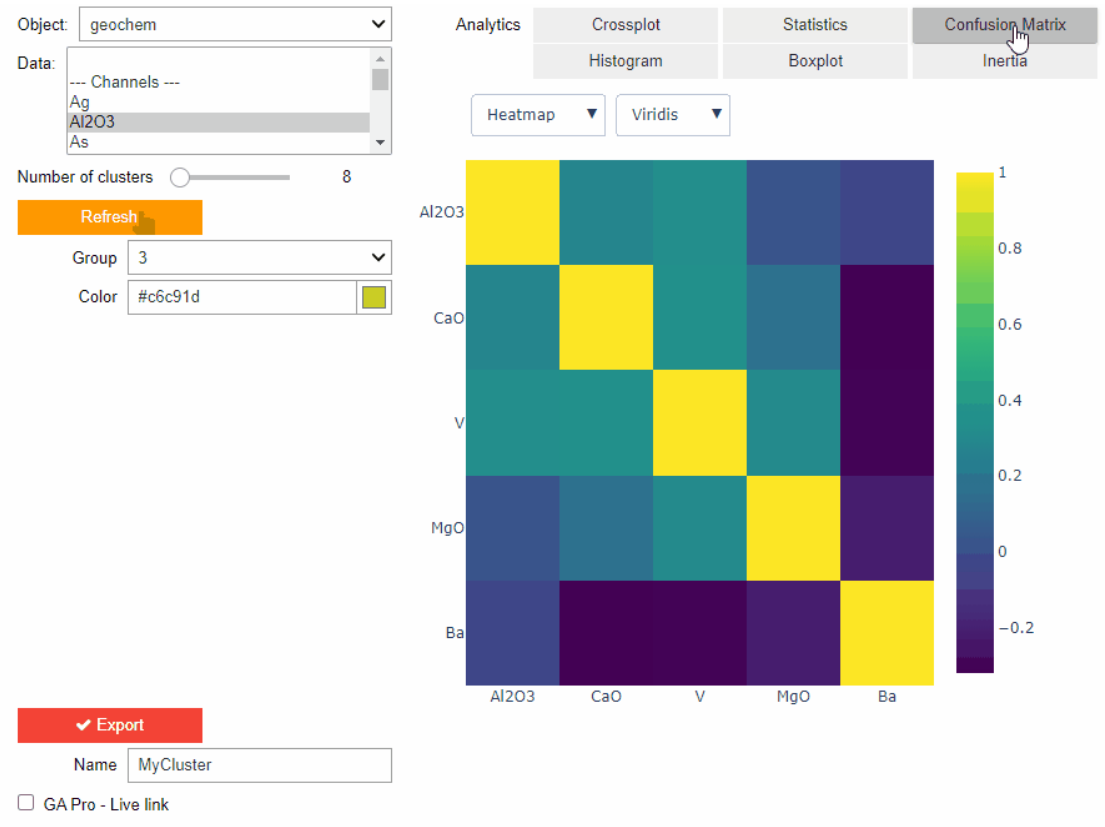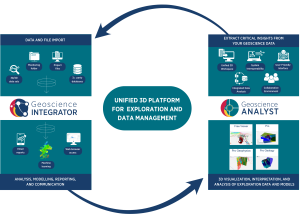Geoscience INTEGRATOR
For Geotechnical and Mining
Data management, 3D visualization, query, and analysis for integration of 3D geoscience and 4D geotechnical and mining data, interpretation, models, files, and documents.
Includes solutions for:
Geoscience INTEGRATOR provides advanced data fusion capabilities designed to address mining industry challenges. It maintains 3D earth model and 4D mine model geometrical data structures, onto which multiple datasets can be projected, interpolated, upscaled, downscaled, or otherwise processed according to data type. This ensures that key variables are co-located in both space and time—a prerequisite for applying advanced analytics and machine learning.
Seamless integration with Geoscience ANALYST establishes a strong quantitative and visual connection between data and models, while embedded Business Intelligence (BI) functionality delivers interactive charts, tables, and configurable data views. Standard import tools can be extended with customized connections to any data source, including real-time feeds, supporting both exploration and operational workflows.

”With Geoscience INTEGRATOR acting as a searchable 4D database, users can query by time as well as spatial criteria. You can ask it to show all data from the past five years or look specifically for legacy datasets, along with common category search functions. That’s a game-changer for discovery workflows.
—Gem Midgley, Principal Consultant at Mira Geoscience

Data management, query, and visualization
Each Geoscience INTEGRATOR server supports multiple exploration projects and mine sites, with access for an unlimited number of users through both a web interface and Geoscience ANALYST. Users can interactively explore data in 2D, 3D, and 4D using spatial, temporal, and attribute-based queries. Historical data can be readily discovered, visualized, and downloaded for further use.
Data management
- Datasets can be managed as user-defined structured tables or as files with associated metadata.
- Formats are free-form, using user-defined templates with any number of fields.
- Supported data types include integer, float, binary, classification, alphanumeric, and date/time.
- Time variance is supported where applicable.
- Document and file manager with extensive metadata.
- Automated data import with user-defined quality control rules.
- Customized pre-processing.
Query
- Query and filter data through both the web interface and Geoscience ANALYST 3D viewer.
- Select by type, name, time range, spatial extent, or other attributes.
- Use user tags, custom metadata, cross-links among data, files, and documents, or polygon-based 3D searches to refine results.
3D visualization
- Direct visualization of most geoscience data types.
- Linked 2D, 3D, and tabular views enable seamless exploration across data dimensions.
- Integrated access to all licensed Geoscience ANALYST visualization, analysis, and interpretation tools.
Automated data fusion for machine learning
Data fusion is essential for applying machine learning in mining and exploration. For example, rockburst hazard depends on geology, stress, production factors, rock mass quality, seismicity, and other variables—yet engineers have traditionally lacked tools to quantitatively integrate them.
Automated, real-time model compilation
- A 4D data framework (x, y, z, t) for spatial and temporal data alignment.
- Automatically imports new data as it is available.
- Automatically co-locates geology, structure, stress, infrastructure, geometry, and production data.
- Supports upscaling, downscaling, interpolation, and projection.
- Supports custom processes to compute variables (‘features’) from raw input data.
- Provides machine learning–ready input for both supervised and unsupervised methods.


Geotechnical hazard assessment
Hazard assessment can run on demand or on a set schedule, typically triggered by new data imports. For example, if seismicity data is ingested daily and the mine model updated, hazard assessments are refreshed at the same frequency.
The approach is proven across multiple mine types (open pit, underground, hard rock, soft rock) and hazards (for example: rockburst, roof fall, slope failure, inflow). Hazards are modeled as 4D functions of time and space at rock interfaces, drawing on dozens of variables compiled through Geoscience INTEGRATOR’s data fusion. Machine learning analyzes mine history against hazard events to define rigorous, data-driven hazard equations.
Automatic data import
- New data ingested via a monitoring folder system.
- Detects files from third-party systems or site personnel.
- Can pull data directly from third-party databases via custom links.
Automatic data fusion
- Imported data is upscaled, downscaled, interpolated, and projected to update the geotechnical model.
-
Powered by a scriptable run-time engine on the Geoscience INTEGRATOR server.
-
Supports advanced computations: onboard microseismic processing, kinematic bench analysis, 3D interpolation of structural data.
Automatic application of knowledge-based or machine learning rules
- Knowledge-based and machine learning rules applied on demand or scheduled.
- Rules application triggered by new data imports.
- Enables timely, automated hazard update.
Automatic hazard reporting
- Reports generated and distributed on a user-defined schedule.
- Hazards above defined thresholds automatically highlighted.
Analytics and reporting
Embedded Business Intelligence tools deliver charts, tables, and data views directly in the web browser. Reports can combine most visualizations into customizable PDFs for ad hoc or scheduled delivery. The 3D visualizer (Geoscience ANALYST) links 2D, 3D, tabular, and statistical displays for integrated analysis.
Web browser charts and tables
-
Generate histograms, scatter plots, ternary diagrams, and time series.
-
Control plotting: linear/log scales, point scaling, coloring by property, tooltips.
-
Apply query filters for precise record selection across plots and tables.
-
View “mine model” data fusion tables and 2D map plots, selectable by elevation and property colouring.
-
Export tables to CSV.
Reports
-
Save chart and table views with plotting parameters and filters for later viewing with updated data.
-
Insert charts, tables, and mine model views into customizable PDF reports.
-
Generate reports on demand or schedule automatic distribution to defined email groups.
3D Visual Reporting
-
Display linked 2D, 3D, tabular, and statistical views of the Geoscience INTEGRATOR database in Geoscience ANALYST.
-
Navigate spatial models while dynamically updating associated tables and plots.
-
Integrate geological, geotechnical, and geophysical datasets in a single environment.

Would you like to see Geoscience INTEGRATOR in action?
Are you using our software and have questions?
Visit our FAQsRelated resources


A robust workflow for regional porphyry targeting; Application to the QUEST-South project area in southern British Columbia

Mira Geoscience receives the 2023 AME Innovation Award

GEOH5: A Framework for Geoscience Data and Model Portability

Clustering data stored on geoh5 objects

Using predictive modelling in mineral exploration

Let the data speak!

Sneak peek v19

Bounding boxes in the viewer

Coal industry solutions

Customized list of file types to help filtering your files




